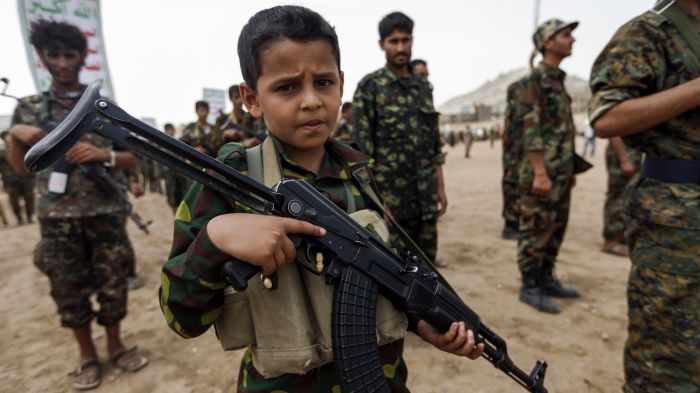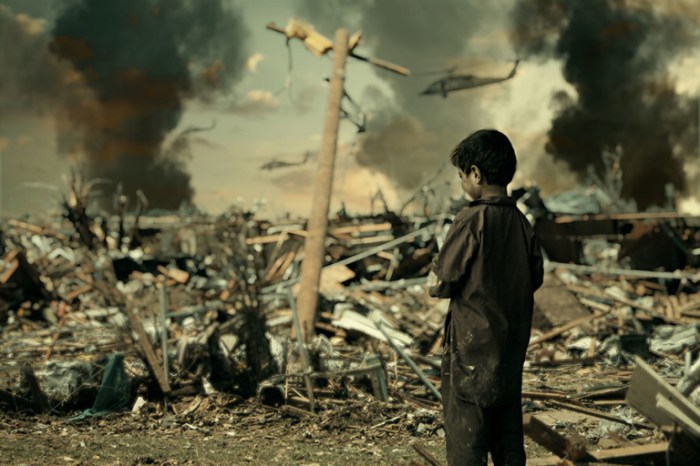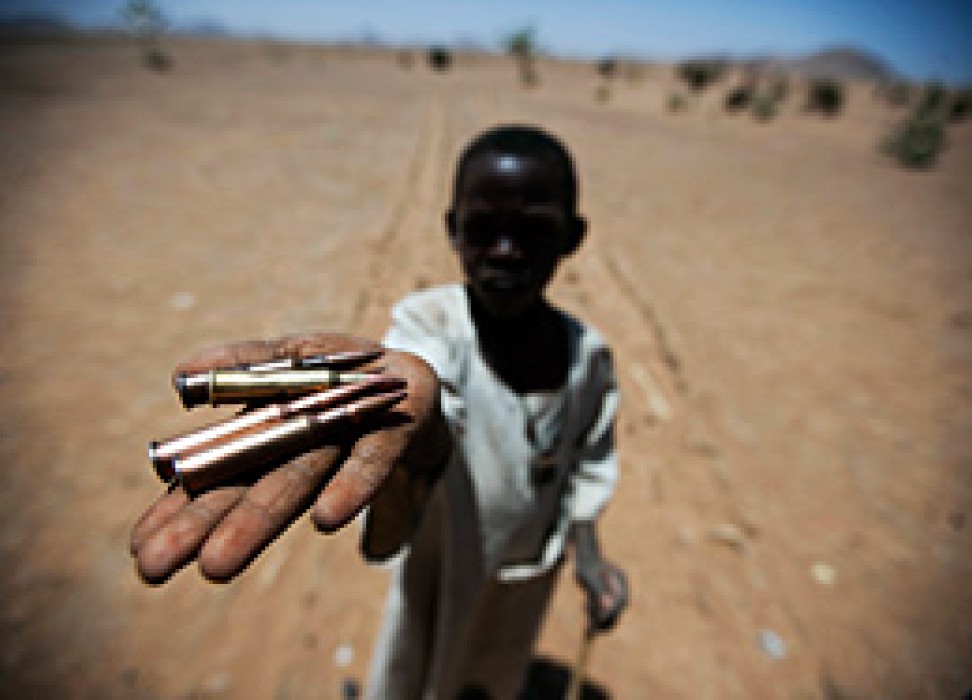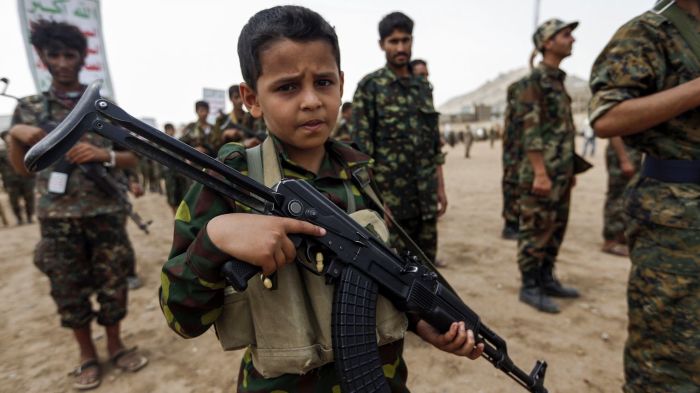
Children Conflicts and the Military: A Complex Reality
Children Conflicts and the Military present a stark reality, where innocence collides with the harsh realities of war. The impact of armed conflict on children is devastating, leaving behind a trail of physical, psychological, and social scars. This exploration delves into the complexities of child recruitment, the roles of militaries in protecting children, and the long-term consequences of conflict on young lives.
From forced conscription to the psychological trauma of witnessing violence, children in conflict zones face a myriad of challenges. This essay will examine the various ways children are affected by war, the efforts to protect them, and the enduring consequences that shape their futures.
The Role of the Military in Protecting Children in Conflict

The military plays a crucial role in protecting children during armed conflict, as they are often the most vulnerable group in such situations. While the primary responsibility of the military is to protect national security, their actions have a significant impact on the lives of children.
Responsibilities of Militaries in Protecting Children
The military’s responsibility to protect children in conflict extends beyond simply avoiding harm. It encompasses a range of actions aimed at safeguarding their well-being, including:
- Implementing child protection policies and procedures: This involves developing clear guidelines and protocols for military personnel on how to interact with children, ensure their safety, and report any suspected abuse or exploitation.
- Preventing child recruitment and use: Militaries have a duty to prevent the recruitment and use of children as soldiers or for other purposes related to the conflict. This includes establishing mechanisms to identify and protect children who may be at risk of recruitment.
- Providing humanitarian assistance: Militaries can play a vital role in providing humanitarian assistance to children affected by conflict, such as food, water, shelter, and medical care.
- Working with other actors: Effective child protection requires collaboration with humanitarian organizations, governments, and other stakeholders. Militaries should actively engage in partnerships to ensure a coordinated response to the needs of children in conflict zones.
Challenges Faced by Militaries in Protecting Children
Despite their responsibilities, militaries face significant challenges in protecting children in conflict zones:
- Limited resources: The military’s primary focus is on security, and resources for child protection may be limited, especially in conflict-affected areas.
- Complex security environments: Conflict zones are often characterized by instability, violence, and the presence of armed groups, making it difficult to implement child protection measures effectively.
- Presence of armed groups: Armed groups often recruit and use children, making it challenging for the military to prevent such practices.
Effectiveness of Military Interventions
While military interventions have been successful in some instances, their effectiveness in preventing child recruitment and protecting children in conflict is mixed:
- The UN Convention on the Rights of the Child (CRC) has been instrumental in raising awareness of the need to protect children in conflict. The CRC’s optional protocol on the involvement of children in armed conflict has been ratified by over 170 countries, providing a legal framework for preventing child recruitment and use.
- Some militaries have implemented child protection policies and procedures, and there have been cases where military personnel have intervened to protect children from harm. However, the implementation and enforcement of these policies vary widely, and there are instances where military personnel have been involved in the abuse and exploitation of children.
- Military interventions have often been accompanied by humanitarian assistance programs aimed at providing support to children affected by conflict. However, the effectiveness of these programs can be limited by the complex security environment and the presence of armed groups.
International Efforts to Address Children in Conflict

The international community has recognized the devastating impact of armed conflict on children and has taken significant steps to address their specific needs and protect their rights. This includes the development of international laws and conventions, the establishment of dedicated organizations, and the implementation of humanitarian aid and development programs.
It’s heartbreaking to see children caught in the crossfire of armed conflicts, their lives forever altered by the violence they witness. Sadly, the United States, through its direct involvement in conflicts around the world us contributes directly to armed conflicts around the world , often fuels these very conflicts, further jeopardizing the safety and well-being of children caught in the middle.
International Laws and Conventions
International laws and conventions provide a framework for the protection of children in conflict. These instruments aim to ensure that children are not directly targeted in hostilities, that they are protected from recruitment and use in armed forces, and that they have access to essential services, such as education and healthcare.
Children caught in the crossfire of armed conflict face unimaginable horrors, from witnessing violence to losing loved ones. It’s a grim reality that makes you wonder, “Why does John Malkovich want to kill me?” why does john malkovich want to kill me – it’s a question that echoes the absurdity of war, a stark contrast to the innocence and vulnerability of children who deserve protection, not bullets.
| Convention | Key Provisions |
|---|---|
| Geneva Conventions (1949) | Protect civilians, including children, in times of armed conflict. |
| Convention on the Rights of the Child (1989) | Guarantees the rights of all children, including those affected by conflict. |
| Optional Protocol to the Convention on the Rights of the Child on the Involvement of Children in Armed Conflict (2002) | Sets the minimum age for recruitment and participation in hostilities at 18 years old. |
| Rome Statute of the International Criminal Court (1998) | Defines war crimes against children, including recruitment and use in hostilities, sexual violence, and attacks on schools and hospitals. |
Role of International Organizations
International organizations play a crucial role in providing assistance and protection to children in conflict zones. They work to ensure children’s access to essential services, provide psychosocial support, reunite families, and advocate for their rights.
- UNICEF: The United Nations Children’s Fund focuses on providing humanitarian aid, protecting children from violence and exploitation, and promoting their education and well-being. UNICEF works in conflict zones to deliver essential supplies, provide psychosocial support, and advocate for the protection of children’s rights.
The way we discuss children’s conflicts and the military is crucial, as it shapes their understanding of both. We need to be mindful of the messages we send, ensuring they don’t grow up seeing violence as the only solution. It’s even more important to consider what happens when those who speak out against harmful policies are silenced, as seen in the case of the Princeton professor and retired marine who was reportedly placed on a no-fly list for criticizing the White House is princeton professor and retired marine on government no fly list for criticizing the white house.
This type of action only further fuels mistrust and makes it harder to have open, honest conversations about the role of the military in our society and the impact it has on children.
- International Committee of the Red Cross (ICRC): The ICRC works to protect and assist victims of armed conflict, including children. The organization provides humanitarian aid, promotes respect for international humanitarian law, and advocates for the protection of children in conflict zones.
Impact of International Humanitarian Aid and Development Programs, Children conflicts and the military
International humanitarian aid and development programs play a vital role in improving the lives of children affected by armed conflict. These programs provide essential services, such as food, water, shelter, and healthcare, and contribute to the reconstruction and development of conflict-affected communities.
“International humanitarian aid and development programs are essential for the survival, well-being, and recovery of children affected by armed conflict.”
The Psychological Impact of Conflict on Children
The horrors of armed conflict leave a lasting imprint on children, shaping their lives and well-being in profound ways. Beyond the immediate dangers of violence and displacement, children exposed to conflict face a range of psychological challenges that can have long-term consequences.
The Psychological Effects of Conflict on Children
The psychological effects of conflict on children are complex and multifaceted. Children exposed to violence, displacement, and loss often experience a range of emotional and behavioral difficulties.
- Post-Traumatic Stress Disorder (PTSD):Children who witness or experience violence may develop PTSD, characterized by intrusive memories, nightmares, avoidance behaviors, and heightened anxiety.
- Anxiety and Depression:The constant threat of violence and the loss of loved ones can lead to feelings of anxiety, fear, and hopelessness. Children may experience difficulty concentrating, sleeping, and maintaining healthy relationships.
- Aggression and Behavioral Problems:Children exposed to conflict may exhibit aggressive behaviors, such as fighting, bullying, and acting out. They may also struggle with anger management and have difficulty controlling their emotions.
- Attachment Issues:The trauma of conflict can disrupt the development of secure attachments between children and their caregivers. Children may experience difficulty forming and maintaining healthy relationships, leading to feelings of isolation and loneliness.
- Developmental Delays:Conflict can hinder children’s cognitive, social, and emotional development. The stress and trauma associated with conflict can interfere with learning, social skills development, and overall well-being.
Trauma-Informed Care
Trauma-informed care recognizes the impact of trauma on children’s development and well-being. It emphasizes a holistic approach to care that addresses the physical, emotional, and social needs of children who have experienced trauma.
“Trauma-informed care is a way of thinking about and responding to the effects of trauma on individuals, families, and communities. It involves understanding the impact of trauma, recognizing the signs and symptoms of trauma, and developing strategies to address the needs of those who have experienced trauma.”
The National Child Traumatic Stress Network
Promoting Resilience and Well-Being
Supporting children affected by armed conflict requires a multi-faceted approach that promotes resilience and well-being.
- Safe and Supportive Environments:Creating safe and supportive environments where children feel protected and cared for is crucial. This includes providing access to safe housing, food, water, and healthcare.
- Mental Health Services:Providing mental health services, such as counseling and therapy, can help children cope with the psychological effects of trauma and develop healthy coping mechanisms.
- Education and Play:Education and play can provide children with opportunities to learn, socialize, and express themselves. These activities can help children regain a sense of normalcy and build resilience.
- Family Support:Supporting families is essential in helping children cope with trauma. This includes providing resources and support to parents and caregivers so they can effectively care for their children.
- Community Engagement:Engaging communities in supporting children affected by conflict can create a sense of belonging and shared responsibility. Community-based programs can provide children with opportunities to connect with others, learn new skills, and build resilience.
The Long-Term Consequences of Conflict on Children: Children Conflicts And The Military

The scars of conflict extend far beyond the immediate physical damage. Children who experience armed conflict often bear the weight of its consequences for years, even decades, after the fighting has ceased. These consequences are multifaceted, affecting their social, economic, and educational prospects, as well as their mental and emotional well-being.
Social Consequences of Conflict on Children
The social fabric of communities is often torn apart by conflict, leaving children vulnerable and isolated. Displacement, the loss of family members, and the disruption of traditional support systems can lead to feelings of loneliness, alienation, and a sense of belonging nowhere.
This can make it difficult for children to reintegrate into society and build meaningful relationships.
- Loss of Family and Community Ties:Conflict often forces families to flee their homes, leaving behind their support networks and sense of community. Children may lose parents, siblings, or other close relatives, leaving them orphaned or separated from their families. This can lead to feelings of grief, trauma, and isolation.
- Social Stigma and Discrimination:Children associated with particular groups or regions involved in conflict may face stigma and discrimination from others. This can make it difficult for them to access education, employment, and other opportunities.
- Disrupted Social Norms and Values:Conflict can erode traditional social norms and values, leading to a breakdown in social order and a decline in community cohesion. This can create an environment where children are more likely to engage in risky behaviors or become victims of violence and exploitation.
Economic Consequences of Conflict on Children
Conflict has a devastating impact on economies, leading to widespread poverty and unemployment. This directly affects children’s access to basic necessities, such as food, shelter, and healthcare. It also limits their future economic opportunities, trapping them in a cycle of poverty.
- Loss of Income and Livelihoods:Conflict often disrupts agricultural production, destroys businesses, and displaces workers. This leads to a loss of income and livelihood for families, making it difficult to meet basic needs. Children are often forced to work to support their families, depriving them of their childhood and education.
- Limited Employment Opportunities:Conflict can create a scarcity of jobs, particularly in sectors that are heavily reliant on infrastructure and skilled labor. This makes it difficult for children to find employment when they reach adulthood, trapping them in a cycle of poverty.
- Increased Vulnerability to Exploitation:Conflict can increase children’s vulnerability to exploitation, such as forced labor, child soldiery, and trafficking. Children may be forced to work in dangerous or exploitative conditions, putting their health and safety at risk.
Educational Consequences of Conflict on Children
Conflict disrupts education systems, leading to school closures, teacher shortages, and a decline in educational quality. This has a profound impact on children’s future prospects, limiting their access to knowledge, skills, and opportunities.
- School Closures and Disruptions:Schools are often targeted during conflict, resulting in closures, damage, or displacement of students and teachers. This disrupts children’s education, leading to learning loss and a decline in educational attainment.
- Teacher Shortages and Lack of Qualified Personnel:Conflict can lead to a shortage of qualified teachers, as many flee to safer areas or are unable to return to their jobs. This can lead to a decline in the quality of education and a lack of access to specialized instruction.
- Limited Access to Educational Resources:Conflict often destroys or disrupts access to educational resources, such as textbooks, school supplies, and technology. This makes it difficult for children to learn effectively and can exacerbate existing inequalities in education.
Mental Health and Well-Being of Children
The psychological impact of conflict on children can be profound and long-lasting. Children exposed to violence, trauma, and displacement often experience a range of mental health issues, including anxiety, depression, post-traumatic stress disorder (PTSD), and behavioral problems. These issues can have a significant impact on their overall well-being, affecting their ability to learn, form healthy relationships, and live fulfilling lives.
- Trauma and PTSD:Children who experience violence, trauma, or displacement are at high risk of developing PTSD. This can manifest in a range of symptoms, including flashbacks, nightmares, avoidance behaviors, and emotional numbness. These symptoms can significantly interfere with daily functioning and relationships.
- Anxiety and Depression:Conflict can lead to feelings of anxiety, fear, and uncertainty, which can contribute to the development of anxiety disorders. Children may also experience depression, characterized by feelings of sadness, hopelessness, and loss of interest in activities they once enjoyed.
- Behavioral Problems:Children exposed to conflict may exhibit behavioral problems, such as aggression, defiance, and withdrawal. These behaviors can be a way of coping with stress and trauma, but they can also create difficulties in relationships and school.





